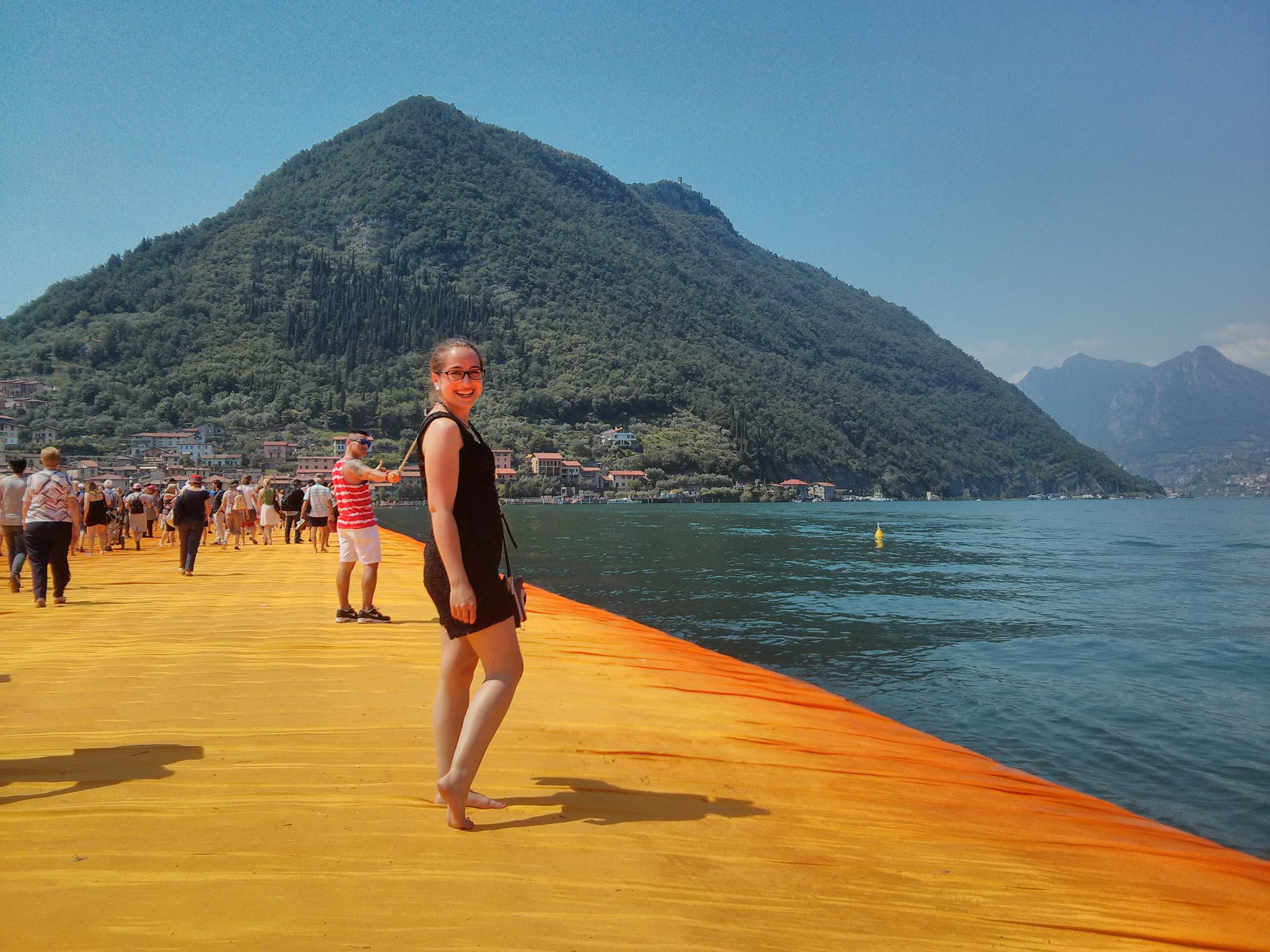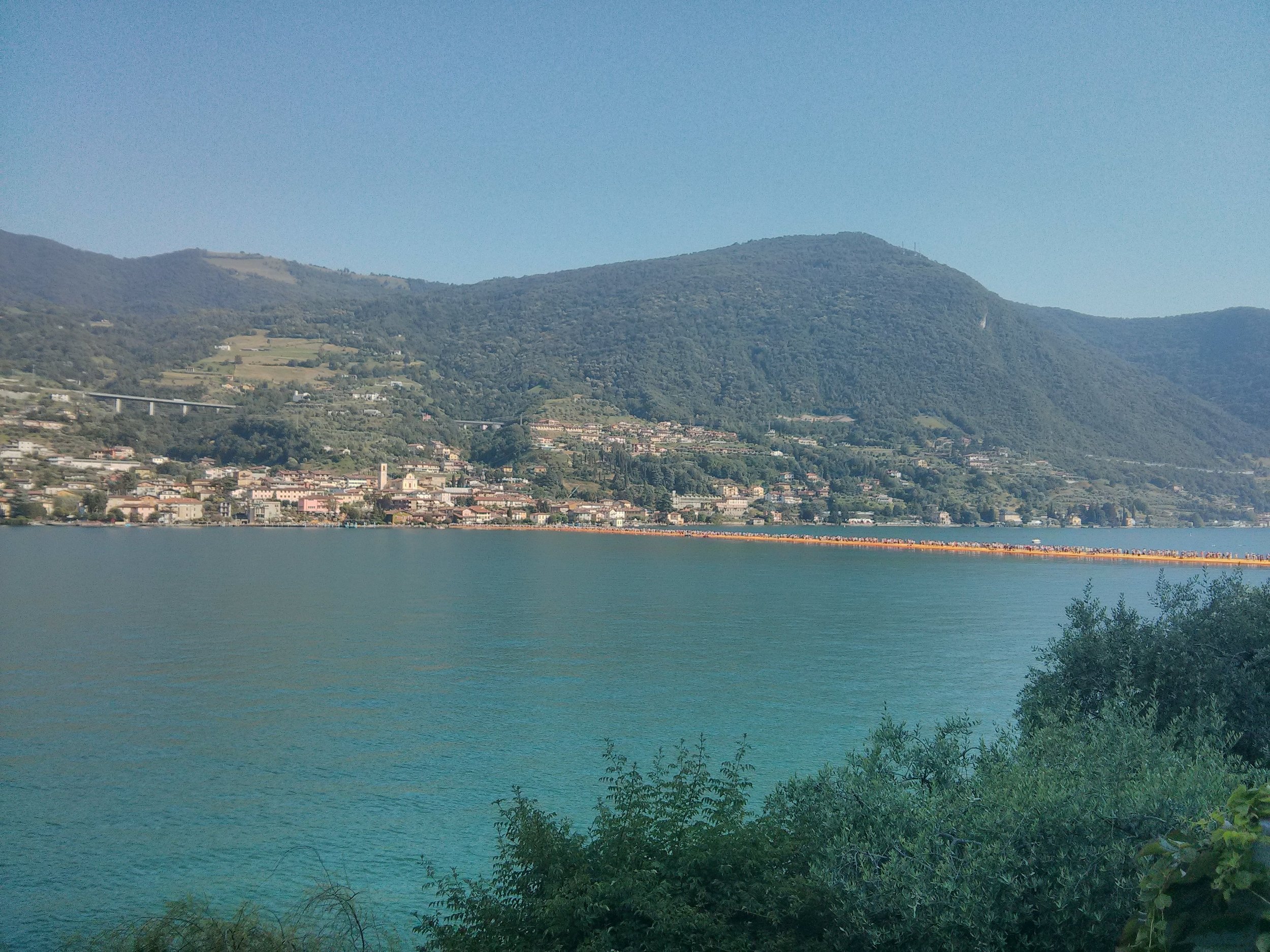Christo and Jeanne-Claude's Floating Piers
/I am so grateful that I got the opportunity to visit the installation Floating Piers at Lago d'Iseo. Even though I have to say, that it has been a real challenge to get there. Surprised by its own success, the Italian authorities fall short to provide a thoughtful plan on how to handle all the visitors coming to see the temporary installation. As we heard on the day before going, that the access was difficult by car we decided to take the train. This is where the real adventure started: We had to wait over 2.5 hours to get into one of the short trains from Brescia to Sulzano, and believe me, waiting in a long line on a hot summer day in Italy is really something you usually want to avoid.
The numbers of people who have come to walk on the free installation have far exceeded organizers' expectations, who estimated around 500,000 would come over the whole project period of 16 days. But the installation has been actually already visited by around 270,000 visitors in less than five days last week. The piers are accessible from 18th of June to July 3, the project will be completely recycled afterwards. Nothing will remain except the experience, memories and some images of the visitors.
When we finally arrived at Lago d'Iseo it has been an incredible experience. The piers connect the village of Sulzano to the island Monte Isola and San Paolo, which is framed by The Floating Piers. I took the chance and sat down to observe the people. Having worked at Art Basel the week before it has been really interesting to see who visited the installation. I knew that a lot of arts professionals wanted to come and see it, but what stroke me most was the variety of people, lots of locals and Italians from other areas, people in wheel-chairs, grandparents with their grandchildren, young and old people. It is in the spirit of the artist duo that their installations are free of charge and attract all kind of interested people, particularly the public that usually does not mingle with the art crowd. Christo said “There are no tickets, no openings, no reservations and no owners. The Floating Piers are an extension of the street and belong to everyone.”
Walking on the piers enables you to really calm down. The piers float on the water and you can feel the movement under your feet. The movement gets stronger when the lifeguard boats, who are patrolling the whole installation to ensure its safety, make their rounds and the short waves hit the installation temporarily. When the helicopters, that are flying tourists over the installation are not hovering over the lake, one can even hear birds. The Floating Piers are conceived to be experienced while walking on them or seeing them from the higher mountain, the helicopter flights are an annoying side-effect of our need for more extravaganza. One has to immerse oneself in the artificial installation to actually get a new view of the surrounding nature. It is a bodily experience that literally bridges human limits, walking on water, with the experience to come as close as one can with this new feeling in nature. Of course, the pun that Christo enables us to walk on water, referring to the biblical scene, passed everyone's mind. And to be honest, there is a transcendental moment in this installation.
The installation consists of a 3-kilometer-long walkway that extends across the water of the Lake Iseo. The piers are comfortable 16 meters wide and covered with a yellow shining fabric, which continues to run along 2.5 kilometers of pedestrian streets in Sulzano and Peschiera Maraglio. To get a sense for the dimensions 100,000 square meters of the fabric has been used, carried by a modular floating dock system of 220,000 high-density polyethylene cubes.
In a time where money decides on power and politics, Christo pays the entire costs of his projects, such is the case with The Floating Piers, which cost around 15 million Euro. It includes the obtaining of all the permissions, manufacturing, installation and removal of the project. He earns all of the money through the sale of his preparatory studies and early works from the 50’s until today. He does not accept grants or sponsorship of any kind, access fees nor donated labor (volunteer help). He does not accept money for things like posters, postcards, books, films or any other products at all. Christo firmly believes that to accept deals of this kind would alter and compromise his art. Refusing this money assures him he is working in total freedom.
Even though Christo's name appears more prominent in the media, one cannot emphasize enough that it is an artist DUO and his wife Jeanne-Claude, who sadly passed away in 2009, played a significant part in all the projects. I guess in artist couples somehow just the male part gets a spot in art history books. Without any doubt, Christo and Jeanne-Claude left their mark in the area of environmental art. Their projects have continuously drawn significant international attention, one of the most notable ones was the Wrapped Reichstag in Berlin in 1995, visited by 5 Million people. Similarly impressive, The Gates in New York City’s Central Park in 2005 was visited by 2 Million people. The current project Floating Piers is the first large-scale installation after New York City and has been first conceived by Christo and Jeanne-Claude together in 1970, but due to the scale and need for permission their projects often need several attempts, lots of patience and joint forces of others in order to be realized.







